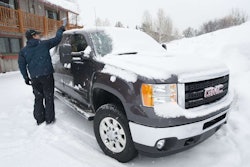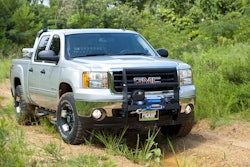 Driving on Gas
Driving on Gas
Bi-fuel Ford conversion runs on both gasoline and CNG – but is it right for your operation?
By Steve Temple
Contractors and fleet managers feel pain at the pump more than most pickup owners, since one of their biggest overhead expenses is fuel.
No surprise, then, many are considering a variety of mileage extenders, using everything from computer tuning modules to fuel additives to alternative fuels.
We’ve been checking out one in particular, Compressed Natural Gas (CNG), after spotting several bi-fuel pickup conversions at this year’s NTEA Work Truck Show.
In addition to already taking a hard-nosed looked at the financial pros and cons of CNG (see Money Matters in our June 2012 issue), we wanted to check out one on the road for a hands-on driving experience.
So we turned to Venchurs Vehicle Systems (VVS) to get seat time in a 2012 F-250 running a dual-fuel 6.2L.
DRIVING CNG
 Bi-fuel CNG tanks are big and take up bed space. This one does
Bi-fuel CNG tanks are big and take up bed space. This one doeshave a small amount of storage above the tank inside the enclosure.
The VVS conversion has the ability to operate on two separate fuel supplies, injecting either gasoline or compressed natural gas with the simple flip of a dash-mounted rocker as you drive.
The transition between the two fuels is seamless, with no obvious changes in performance.
Venchurs system ports CNG directly into the cylinder, and by optimizing the tune and air/fuel ratio, using CNG loses only three percent in power, which is said to be within the five percent variance found in manufacturers’ OEM engine ratings.
Clean Energy, a key supplier in the natural gas market, says a CNG-only engine would normally provide the same power output, but noted it’s difficult to optimize an engine for dual fuels, suggesting one possible reason for the slightly lowered output of the Bi-fuel application.
Even so, the VVS conversion does not significantly affect cargo hauling or tow ratings, and the fuel economy is claimed to be 11 mpg in the city and 14 mpg on the highway.
In gasoline mode, the dash readout indicated 15 mpg on the highway at 65 mpg (Ford does not publish fuel economy ratings on this size of truck). Also, the truck’s onboard computer does not provide fuel consumption data when running in CNG mode, so we used the traditional method of counting miles and volume consumed to verify Venchurs’ mileage claims.
Even though the observed fuel economy is about a mile-per-gallon less with CNG (in an engine with a dual-fuel capability), it can dramatically reduce fuel costs, since the price of CNG runs $1.25 to $2 less on a per gasoline gallon equivalent (GGE) basis.
There’s an even greater fuel savings compared to the cost per gallon of diesel. But keep in mind diesel has a higher energy rating of 129,488 Btu/Unit, while CNG’s is 98,300 Btu/Unit, according to the Department of Energy.
So no surprise that the horsepower and torque outputs on the slightly larger 6.7L Power Stroke are significantly higher than gasoline (400hp vs 385, and 800 lb/ft vs 405).
Another point in favor of a VVS conversion (available on the 6.2L F-350 as well) includes its designation as a “Ford Qualified Vehicle Modifier.” That means VVS conversion won’t void the factory warranty and can be rolled into Ford financing programs.
Moreover, the residual value of vehicles with CNG conversions tend to be much higher, possibly even more than upgrading to a diesel engine.
QUICK ROI
Given these facts, you might think it’s an ideal way for a contractor or fleet owner to save money on fuel expenditures. Is that the case? Well, yes and no.
If you’re driving 30,000 or more miles per year, which is a typical number for our readers, in a few years you could probably recover the $11,000 cost of a bi-fuel CNG upgrade (for a single vehicle—fleet pricing would be less per vehicle).
 Using CNG requires a brief safety lesson before you get a PIN to use for filling your vehicle.
Using CNG requires a brief safety lesson before you get a PIN to use for filling your vehicle.
How soon you could offset the expense of that upgrade, however, depends on several factors, such as the volume of fuel consumed, market fluctuations in fuel prices and reduced maintenance expenses.
Considering just one scenario, using an annual mileage figure of 30,000 and approximate mpg figures noted above (14 vs 15 mpg), you’d consume 2,143 gallons running solely on CNG, compared with 2,000 gallons of gasoline.
As of this writing, the nationwide average price of CNG is $2.13/gal and $3.70/gal for regular unleaded. That pencils out to annual fuel expenditures of $4565 for CNG, and $7400 for gasoline at those prices.
Another variable to consider is even though the fuel efficiency of bi-fuel is slightly less than with a conventional gasoline or diesel, the cost-per-mile is also lower because recommended maintenance intervals are increased, due in part to reduced emissions and particulate matter.
LOST BED SPACE
The downsides? Well, an obvious one is the size of the tank.
On the F-250 tested, what looks to be a big diamond-plate toolbox is actually a federally-required safety cover housing a carbon fiber 22-GGE CNG tank.
While other tank sizes and configurations are available, this one took up about a third of the cargo bed. With the tailgate lowered, you might be able to load some 4×8 sheets of plywood in there, but that would make sense for only occasional, short-haul trips.
Given the generous load capacity of a Super Duty, the increased weight of the extra tank and fuel is not all that noticeable, so there’s no obvious impact on handling or performance.
AT THE PUMP
Filling up at a CNG station isn’t like the typical fuel stop. CNG fueling requires a short learning curve, consisting of watching a brief safety video on locking the hose valve in place and getting a reusable PIN code. It also takes a little more time.
The filling time at 3600 psi (instead of the older 3000 psi) for a 22-gallon tank takes a few minutes longer than with a conventional gasoline tank. The pump is also noisier and there’s a hiss when the hose valve is disconnected from the tank fitting located right next to the filler neck for gasoline.
Slow-fill home versions, which compress natural gas fed from a utility pipeline are available as well. But they are under lower pressure and take several hours for the refuel process.
In sum, we’d say the VVS bi-fuel CNG conversion would be a viable choice for fleets and contractors who have ready access to CNG stations, don’t have to carry large loads in the bed, and spend a lot of time on the road overseeing far-flung jobsites.
BASIC SPECIFICATIONS
Make/Model: 2012 Ford F-350 Crew Cab 4×4
Base MSRP: $29,065
As-Tested MSRP: VVS Bi-fuel option adds $11,000
Engine: 385 HP, 6.2L 2-Valve SOHC.
Torque: 405 lb-ft @4,500
Axle Ratio: options range from 3.31 to 4.30
MPG/EPA: 15 City/18 Hwy
Observed MPG: 15mpg gasoline; 14 mpg CNG
Fuel Capacity: 35 gals (plus 22 gallons of CNG)
Tow Capacity (model tested): 12,500 lbs weight-distributing
Payload capacity: 4,080 lbs
Tires/wheels: size/type: LT245/75R17
SOURCES
Venchurs Vehicle Systems: 517-263-8937; venchurscng.com
Clean Energy: cleanenergyfuels.com







